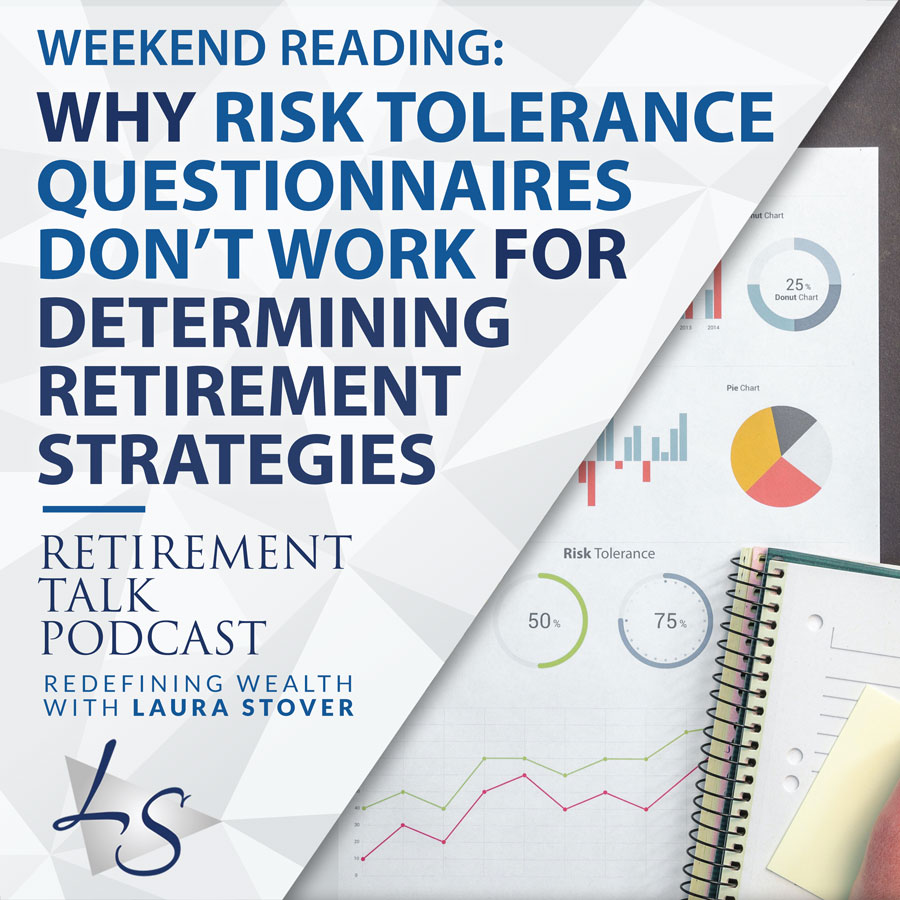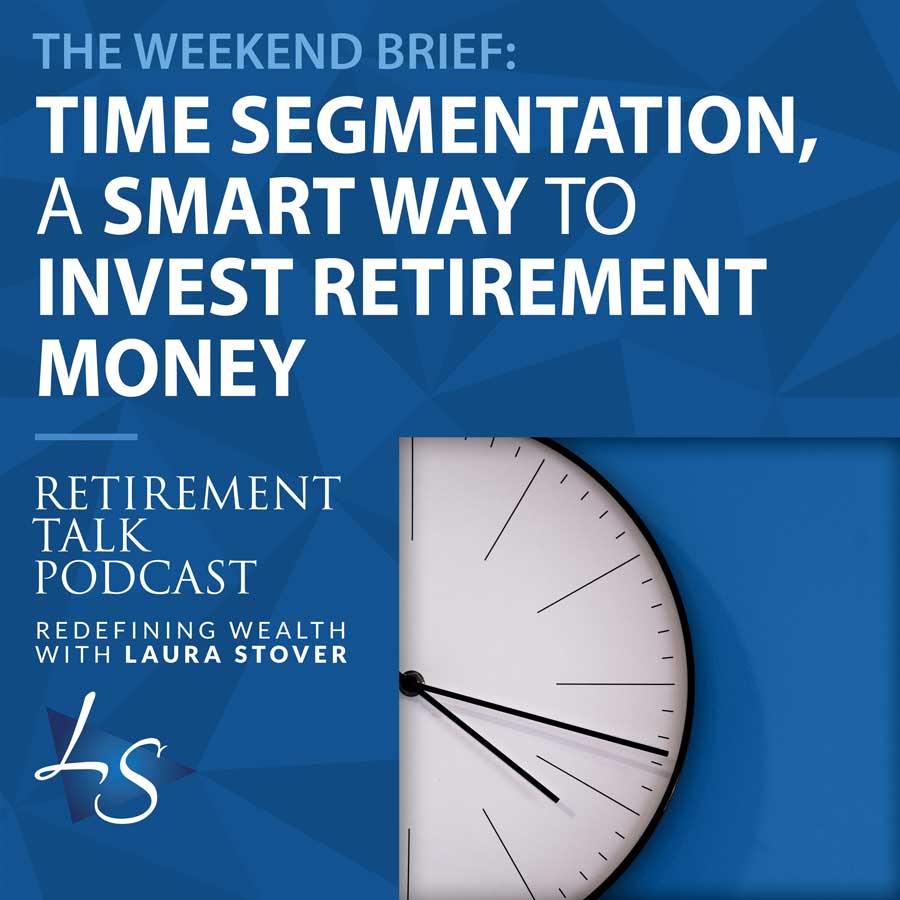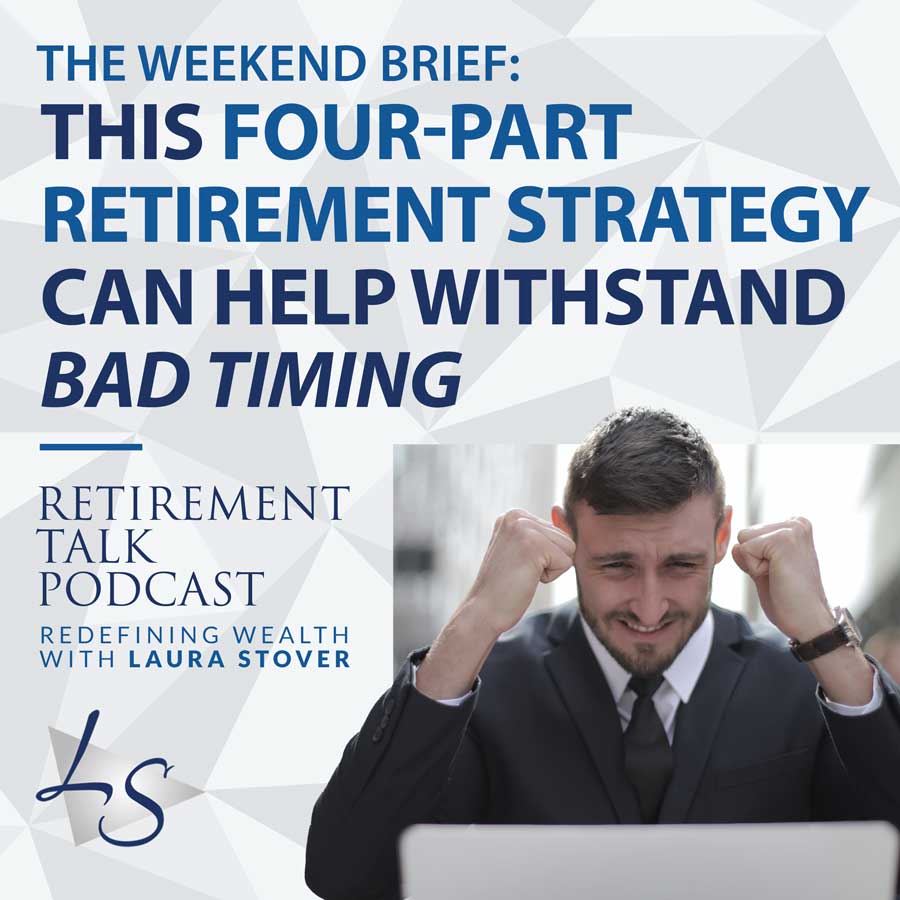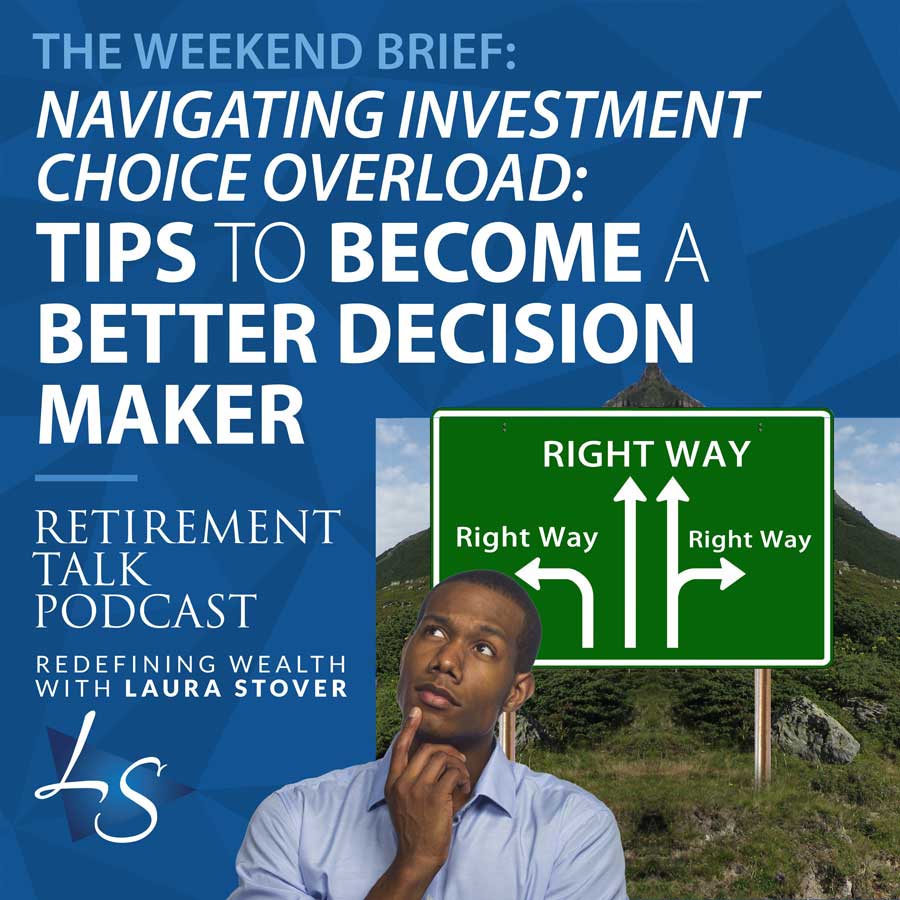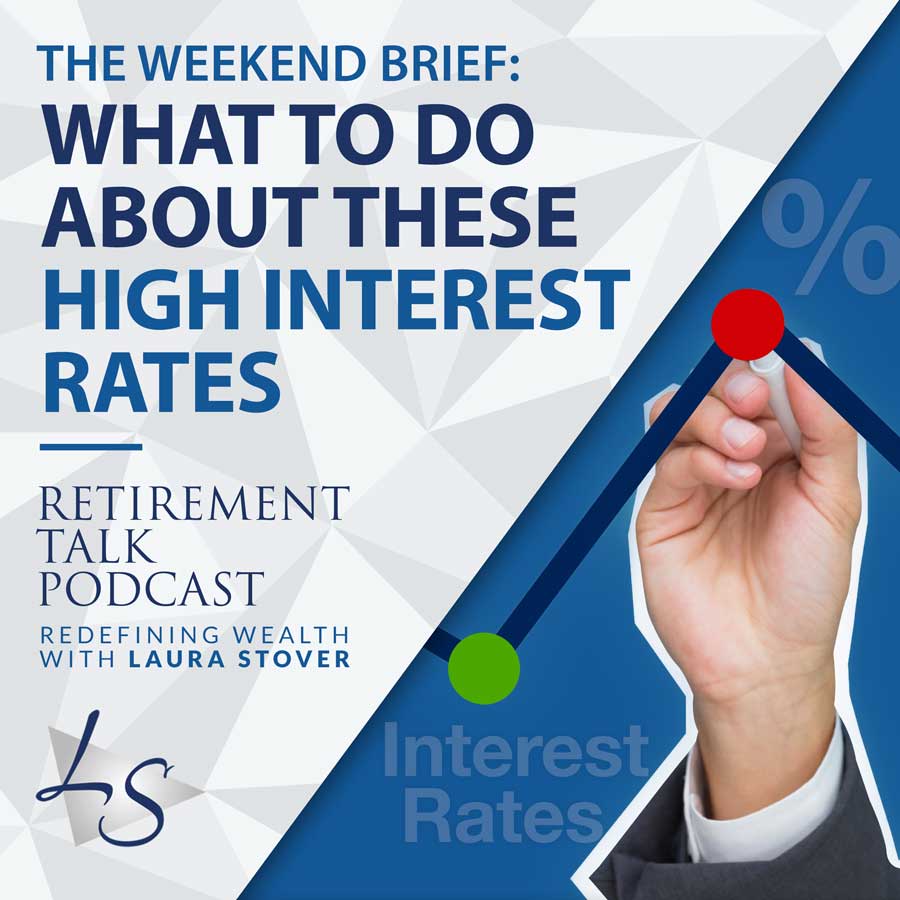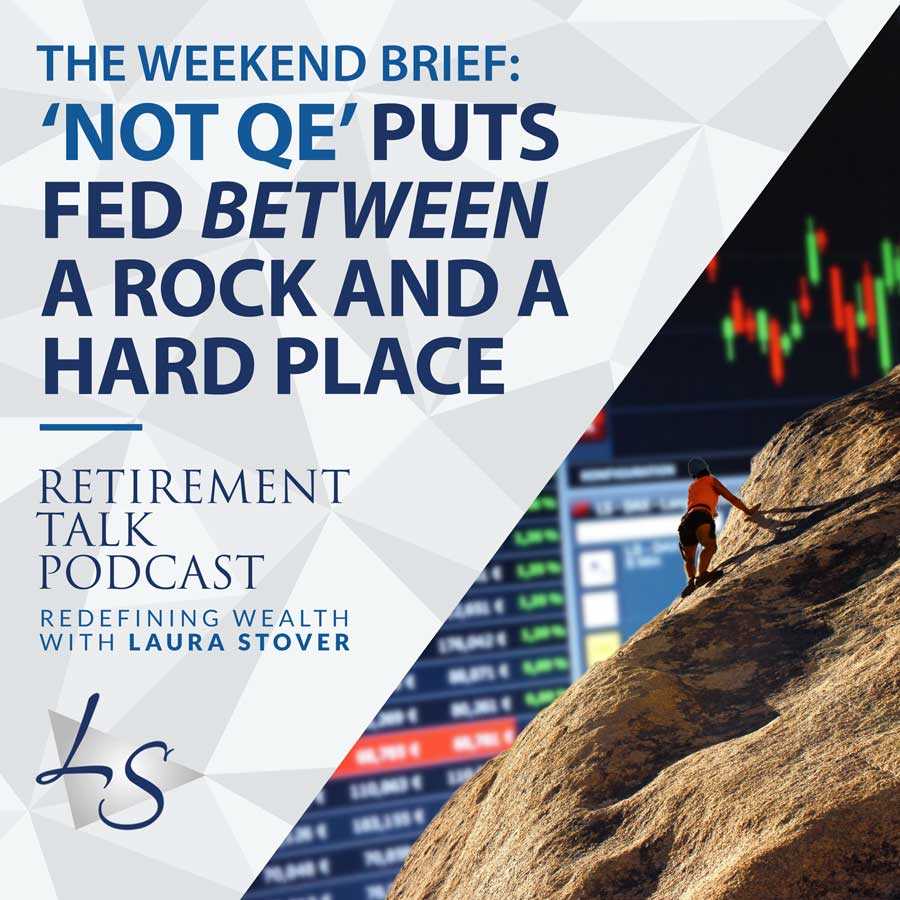When planning for your retirement and the strategies you’ll use to plan for it, many firms will have investors complete risk tolerance questionnaires. While these work to get a base-line understanding of where you are, they are an outdated approach for planning.
In this episode, we’re discussing what these questionnaires ask, why they’re outdated, and the three L’s that Dr. Wade Pfau believes you should be concerned about when planning for retirement.
Review the article mentioned in today’s show >>
Rate & Review the Podcast on your favorite podcast app!
Sign Up for The Weekend Reading Email to read more on the featured podcast: redefiningwealth.info/weekend-reading
Show Notes
Potential Questions Investment Firms Will Ask You (3:25)
Funding Expenses from the Investment Portfolio (5:44)
Outdated Approach of Questionnaires (6:22)
Inflation (7:13)
Proprietary LifeArc system (9:40)
Three L’s #1: Longevity Risk (10:18)
Three Components to Consider for Risk Profile (10:48
- Risk Capacity (Emotional Side)
- Financial Independent Score
- Behavioral Finance
Three L’s #2: Lifestyle (14:06)
Three L’s #3: Liquidity (15:18)
Life Changes & Events Impact Us (16:10)
RISA (20:19)
Total Return Approach (21:18)
Geometrically Compound the Portfolio (24:15)
Segmentation Approach (25:38)
Goals-Based Planning (26:14)
Links
Weekend Read: redefiningwealth.info/weekend-reading
Listen & Subscribe
Ron:
Welcome to Retirement Talk, the Redefining Wealth show specifically for pre-retirees and retirees to help you better understand and navigate and educate during these financial times. We are here to discuss thoughts and ideas with some of today’s foremost experts in the field of finance and retirement as well as discuss trending topics that could impact your bottom line. These discussions can help you make better financial decisions and be informed so you can live the lifestyle you imagine and make better financial choices.
Ron:
Laura Stover is a registered financial consultant and CEO of LS Wealth Management, as well as founder and owner of the LS Tax, a consulting firm. She’s been featured in Forbes, CNBC and the Wall Street Journal. I’m Ron Stutts. Our topic for today comes from our Weekend Reading edition, it’s from Advisor Perspectives, Why Risk Tolerance Questionnaires Don’t Work for Determining Retirement Strategies.
Ron:
If you would like to learn more on today’s topic, head on over to redefiningwealth.info and subscribe to the Weekend Read. You’ll receive the Weekend Read each and every Friday along with Laura’s breakdown on the topics important to you and your retirement. Now, here are your hosts for Retirement Talk, the Redefining Wealth show, Laura Stover and certified financial planner, Michael Wallin. Welcome to the show.
Laura:
Hello, hello, hello. This is our Friday edition of Weekend Reading where we cover one of the four articles that I send out as part of the Weekend Reading email series and we have a lot of great information, the cliff notes basically in the show of a very important topic regarding risk tolerance questionnaires and how they don’t work for determining retirement strategies at least from my favorite professor, Michael, my favorite professor, Dr. Wade Pfau. He is a Princeton guru and authority in our industry with retirement income planning.
Laura:
He is the creator of the RICP, which is a great designation through the American College that focuses specifically on income planning, a researcher, a wonderful person in this article that we’re going to be featuring today. If you are nearing retirement, if you are taking income from your portfolio or maybe you are thinking of transitioning from all the fun of working and heading into retirement, this is an important article for you and you can get the link to the article in the show notes. Go to redefiningwealth.info and check out the podcast.
Laura:
This article is focused on how we get there with the risk tolerance questionnaire. It’s just one element. It’s one element of a bigger picture when it comes to creating an income strategy for retirement. There’s so much more that really needs to be part of that process. All firms, if you can fog a mirror… Michael, if you can fog a mirror, you’re going to be a number with most firms out there and everyone to open an account, you have to say what’s your time horizon, how do you feel if the market were to go down maybe 10% or 20% or 30%. And they’re going to ask you a variety of questions. How long until you think you’re going to need to have to withdraw income from your account? Usually, there’s 10, maybe even 20, if they’re a little more elaborate, you might have a 20-question risk profile. And since we’ve come into this industry, we’ve always had to use one, but I kind of equate it to… Do you remember 8-track tapes, Mike?
Michael:
Yes. Matter of fact, this last week, I was cleaning out a box in the very back of the closet and came across one that I thought of you and it was of Elvis Presley. And I said, “I have got to save this and get this over to Laura. She would greatly appreciate it.” But yes, the 8-tracks were the cream of the cream of the best technology at the time, however, may not be the best today. And it’s kind of like the same thing with these risk questionnaires and Wade, in his article here, he’s not dismissing the use of a risk questionnaire, but saying let’s maybe dial it down. It is not the all in all answer to understanding where a person is and how they’re going to react or what type of risk exposure they need to make their plan successful.
Michael:
In the article, he uses an example of going to the doctor to have their cholesterol checked and instead, they check your pulse. You want to check all those elements, but on the way to retirement, you are investing for the long term. The questionnaire may test you on what you can stomach, but it doesn’t necessarily test your investment capital, what you need to have, how much full risk is necessary to make your plan successful. It’s only really identifying what are you willing to tolerate or you think that you could tolerate.
Michael:
Funding expenses from the investment portfolio, that needs to be included into that consideration. And so, that’s why we may not want to put all of our confidence just in one single 10 or 20 questionnaire profile, but really looking at what are all the risk and what is the unique circumstances around that client to understand how that portfolio needs to be designed and sometimes, you may not have a stomach for it, but you may have to have a little bit more risk to make your plan a reality during your retirement years.
Laura:
Well, it’s an outdated approach is really the thesis of Dr. Pfau’s article that we are indeed featuring, and he’s wrote some fabulous books. There’s a new one out recently, a retirement guide and safety-first, he wrote over the summer, and I hope to have him on the show in 2022 and talking specifically about income planning, but like the 8-track tape, we’ve evolved from the 8-track tape era to technology that maybe I’m not even up on with MP4s and you got all this iCloud stuff and these Google Drives and all of this modern technology that makes things so much more convenient, and it can do so many more things with the technology today.
Laura:
And that’s kind of a decent parallel when it comes to the topic of the risk profile questionnaire, spending shocks, inflation. We’ve seen inflation. It’s what? Over 5.4% so far here in 2021. And it’s probably going to continue unfortunately to escalate. Oil is at an all time high, long term care costs, there are new retirement risks. This is what Dr. Pfau talks about. And the old risk profiles do not take some of these things into consideration, which we call risk perspective, risk capacity, out living your money. People living longer.
Laura:
The original questionnaires were incepted many, many years ago, and they’re required by FINRA, by the regulators, so we have to utilize what is the standard, but the standard is based on regulations and laws. I mean, some of these laws go back clear to 1933. The Investment Act of what? 1933, 1935. I’m sorry, but the world has changed immensely over the course of this time, so outliving money is a very real possibility. Non-discretionary expenses, making certain you don’t outlive that money, covering the basic living expenses, maintaining a base level of independence. Food, healthcare, lifestyle is very different. Maybe you’re looking in retirement and most parents help their kids. You’re going to go on vacation and spend time with your kids. Now, when your kids are 40, you’re probably still going to help them, but not the same as when they’re little, now.
Michael:
I hope not.
Laura:
And you have girls, we know girls cost more than those poor little boys. These are very real retirement concerns and there’s new retirement risk and they can be classified into several distinct areas, longevity, which he talks about these three L’s that we’re going to get into, longevity being the first one. And this is where the questionnaire must parallel with the new risk that we have today. I’m just going to digress slightly. We’ve addressed this, the proprietary LifeArc system that we utilize with all of our clients. We’re having existing clients, clients I’ve had for 20 years when this technology came out, go back and then put their information so that we can dissect this on a much broader basis and that’s exactly what he is talking about. Most examples center on financial independence, knowing you can pay your basic expense and not be a burden to others and longevity being one of the 3 L’s that he talks about.
Michael:
Longevity risk is a major factor, whether you’re looking at where you’re going to invest your money, your risk profile should come back and like you said, there’s three different components that a person should look at. Not that one-dimensional static document, but really, a dynamic document that we use through LifeArcPlan, risk arc elements is that component that we use because it measures three different separate areas.
Michael:
You look at a person’s risk capacity. That is that emotional side of what do they think they could tolerate. And then you have your second one, which is the financial independent score. And that’s based upon how well a person has done and if they’ve done really well, maybe they can reduce down the amount of risk exposure necessary to make their plan work through that longevity risk. And then the third component is that you start really looking at behavioral finance and that’s, we’ve had a couple of podcasts that we’ve talked about that. Behavioral finance is really what is your internal innate characteristic that would typically cause you to blow up your retirement plan.
Michael:
And Laura, we’ve had these clients come in that have sat down with us on a Monday that the market, they’ve heard the last news, and a lot of this is recency bias, but they come in, they sit down at the table, we ask them to complete a questionnaire with us. They fill it out and they are super aggressive because the last thing they heard was that the market is doing great and they fill it out and then we process the business. We put it in place. Two weeks later, we’ve allocated the accounts and the market has the slightest correction to it. A slight, slight correction, the market may bump down 1% or 2%, or we may have two or three days that we’re-
Laura:
Michael, I want to make a 25% return, but I don’t want any more than a 1% deviation at any point in time.
Michael:
That’s right.
Laura:
Now, if you can’t do that for me, I’m going to find me another advisor.
Michael:
We hear that all the time. And it’s like, wait a second, you said you could tolerate the market being down by 10%, but you really couldn’t tolerate it for a week and certainly couldn’t tolerate it for a year or two years. Those are the dynamics of what you’re talking about where these questionnaires may be a little outdated because individuals are getting information much faster now, they’re getting it off the Internet. They’re getting it from news cycles. It’s much different than it was 20 years ago. And our technology has to be better and it needs to look at an individual holistically, multidimensional, not one-dimensional in a static form.
Laura:
I think people think they’re making a lot more. We see this oftentimes too. They believe their rate of return is much higher than it actually is most of the time I had a listener on our podcast email and he’s thinking through his strategy whether or not he needs a trust, also the concept of laddering bonds. And I have a lot to respond back. I mean, right now, this year, do we want to rely on retirement income exclusively with laddered bonds? I don’t think so. And typically, the brokerage world is going to utilize that as the conservative hedge within a lot of portfolios and with the treasury rate being so elevated, the infusion of all this money, Fed is going to start pulling back on tapering. The bond yields have been very, very flat and actually even a little bit negative in the first quarter of this year.
Laura:
And the other aspect of this, the three L’s that Dr. Wade addresses, longevity being one, and then lifestyle. Now, lifestyle concerns… that’s going to focus on maintaining your desired standard of living, the way you enjoy life throughout your retirement and that involves more discretionary spending. And this aspect of retirement planning includes maintaining or improving your current lifestyle rather than behaving more frugally than you would throughout your retirement.
Laura:
Now, the funny thing is whether it’s funny or not, I think it’s kind of humorous. Most people think they’re going to spend less in retirement. Typically, studies show the first two years, people spend more. Now, be pre-COVID, but they’re going back now out to eat more, traveling more. They have all this free time. They’re at home more, so what are they doing? Remodeling the house. You’re seeing all the flaws maybe around you or you want some updates on things. People are spending more when they step into retirement, so that phased retirement can be very beneficial. And so, that’s the second L that he talks about. And the third L here being liquidity, maintaining the reserves that you need for the unexpected.
Michael:
Liquidity concerns affect everybody. I mean, you’ve got to make sure, and we talk about this. When people come in, they sit down, we put them through the LS Wealth process is you’ve got to bucket your money and you’ve got to have money that you have accessible to you because life changes, events change. You’ve got to make sure that you can maintain enough reserves for those unexpected contingencies, market downturns. If the market goes down and you have been pulling dollars from your retirement accounts and the market goes down, you may want a different bucket that you’re pulling money from when that happens because you don’t want to get a triple compounding in reverse on your investment accounts.
Michael:
Illnesses can occur. As we age, events happen. I know of a gentleman that 60 days ago was fit as a fiddle, a good friend of mine. And in 60 days, Laura, this gentleman has gone through a situation where his vertebrae in his back crumbled. He had to go in and get a new vertebrae put in. That’s now causing the L4 and L5 to have problems. They determined he had cancer while he was in there. It became through an observation that there was a problem. And last week, he had a heart attack. This is 60 days. Life changes and you need to make sure that you’ve got the proper resources set aside.
Michael:
What Dr. Pfau calls them are spending shocks. I can promise you, this gentleman has gone through spending shocks over the last 60 days that has quickly occurred or for our clients that have experienced, in 2020, we had a waterfall movement in the market from March 4th that went for about 45 days there of a contraction in the market. What are you going to do for those contingency plans? How much flexibility do you currently have in your retirement plan and as well as in your income plan? Maybe you’ve overweighted your lifestyle having the right balance between liquidity and lifestyle and longevity, understanding how you derive income out of your accounts to have that balance is critical.
Laura:
Well, the risk profile doesn’t provide income planning, and we see much more volatility, a faster moving market. We have to have a deeper meaning than what these old risk profiles were. They’re kind of everything… assessing everything in a vacuum, and you’re either a number seven or a number four with your definition. And you’re pulled with millions of other people’s interpretation of the question. It’s kind of a cookie cutter approach and the whole industry’s been based on accumulation. Take more risk to grow your account, risk-reward, more risk equals more reward, but that is not necessarily the case because dollars and percentages are two very, very different things. And I think if you try to fit everybody into a risk model using those risk tolerance questionnaires, that is like a doctor, as you stated, he uses the analogy, trying to check your pulse to measure your cholesterol. There’s nothing wrong with checking your pulse, but that’s not what we were trying to accomplish. We needed something else and that is a very true analysis here.
Michael:
Everybody’s life is different. You need to, we always say, unpack, but it’s very much that when you’re looking at identifying a client’s investment strategies and their risk profile, you need to unpack all the different elements that makes them multidimensional, and then understand how each of those components come together to determine what really is the right risk measurement needed to make their plan successful.
Ron:
You’re listening to Retirement Talk with Laura Stover and Michael Wallin. If you would like to read more on today’s topic, take advantage of a free subscription to the Weekend Read. Go to redefiningwealth.info/weekendread and click subscribe. You’ll stay on top of all the latest news and financial trends. Finally, we want to invite you to our upcoming webinar. Laura and Michael will take a deep dive into important concepts that will help educate you on making informed decisions for your retirement. These resources are available to you by going to redefiningwealth.info. Subscribe to the Weekend Read. We help get you on track and stay the course. Now, back to Retirement talk, the Redefining Wealth show with Laura Stover and Michael Wallin.
Laura:
Because of the concerns outlined, Dr. Pfau talks about various income strategies and one word and acronym that he has utilized is an approach utilizing an alternative test, the RISA. And using this in the de-accumulation period, because most of these risk profiles focus on accumulation, not de-accumulation, which is a specialization in and of itself and we really need to change our mindset from all accumulation to de-accumulation as we are 5 to 7 to 10 years out from retiring or in retirement. These concerns are going to focus on retirement income them strategies. And they’ve been developed to source retirement income in a different manner than how you manage those investments during the accumulation years.
Laura:
And some of the common strategies include number one, what we refer to, Michael, as a total return approach. This means you would draw income from a diversified investment portfolio. The traditional fact finders do not include diversifying the income component and maybe we’re using contractual sources to fund some of these retirement expenses, then you can expect portfolio growth to support a sustainable spending rate. And in addition, if you don’t mind the inherent variability of drawing income from an investment that will fluctuate in value, there’s the creation in need for income planning.
Michael:
When we look at the LS Wealth process, Laura, one of the things that we look at on the total return, not just in the investment side where we’re looking at maybe an investment strategy that has the appreciation value, but also dividend approach. We’re looking at that balance between value and growth inside of it, but also when we look at the total return approach, we’re also looking at the way we manage money. And I think that’s a dynamic that is very applicable here.
Michael:
Many people, when they’ve used risk questionnaires in the past, they’re looking at strategic investing where we’re using tactical investing for a lot of our clients and tactical investing may allow us at times, based upon algorithms or mechanical approaches of taking people in and out of the market, we can actually be a little bit more aggressive in our investment strategy, but yet have a much lower risk profile for the client because we will switch between an equity position, 100% there to maybe moving to a much lower as volatility occurs, because of the diversification and the activity that we’re doing on a tactical basis that provides a much better solution for many clients as they go into the early stages of their retirement.
Laura:
And the ability to identify these preferences is going to allow us to better assess retirement income strategies that resonate with each and every individual that your circumstances are unique like a fingerprint, not cookie cutter with… far too often, that seems to be unfortunately where we see most clients are in what I would refer to kind of as a cookie cutter plan. And during the accumulation phase, that may not be quite as impactful because your dollar cost averaging, you’re putting money in the market on a consistent basis and a very long timeframe for those assets to grow.
Laura:
Now, we transition or we’re getting ready. We have capital accumulated, we’ve saved, we’ve saved, we’ve saved. Now, that capital must be preserved, and in order to geometrically compound the return, we’re looking at two different things. The tactical strategic blend that you just spoke of, meaning when the market corrects substantially, we’re talking 20 plus percent or more, 30%, even though the market recovered at an all time fast pace that typically does not happen like it did in 2020, everything about 2020 was an anomaly.
Laura:
It was a true black swan event, 22 trading days to hit a 34% low and then a speedy recovery within the same month of 12%, you cannot guarantee that’s going to happen every time there’s a correction. To geometrically compound the portfolio, what you’re talking about is that blend where there’s mechanisms in place to preserve the dollars in the portfolio. We’re not focusing on rate of return, we’re focusing on preserving the dollars so that when the market comes back, there’s more capital to appreciate and compound on.
Laura:
That’s the difference between dollar returns and percentage returns. Then, the element of diversification, understanding discretionary and budgetary expenditures that you should never risk and having diversification here where the income is ironed out, maybe with contractual guarantees and then maybe we’re using a segmentation approach that you speak of often, Michael, where assets that you’re not dependent upon right now today, have a distinct goal to earn specific amounts over the course of a designated duration or period of time.
Michael:
It’s all about goals-based planning. And I think that when people do that, and then they align their risk profile with their actual overall plan of making sure that they have enough resources to live their lifestyle, I think that’s where those two pieces of the puzzle comes together. This is the reason why we look to the LS Wealth process, because it is a proven system that allows individuals to come in, measure what they need in the future, identify their risk today, but also the dynamic of how they’re investing to make sure that they give themselves the highest probability of success throughout their retirement years.
Laura:
If you would like a link to the article, again, check it out in the show notes, and we’ll be getting you a new article each and every Friday. Simply go over to redefiningwealth.info. Subscribe for free to the Weekend Read.
Ron:
Redefining Wealth is a registered trademark of LS Wealth Management. Investing involves risk, including the potential loss of principal. Any references to protection, safety, or lifetime income generally refer to fixed insurance products, never securities or investments. Insurance guarantees are backed by the financial strength and claims paying abilities of the issuing carrier.
Ron:
This show is intended for informational purposes only. It is not intended to be used as the sole basis for financial decisions, nor should it be construed as advice designed to meet the particular needs of an individual situation. LS Wealth Management LLC is not permitted to offer and no statement made during this show shall constitute tax or legal advice. Our firm is not affiliated with or endorsed by the US government or any governmental agency.
Ron:
The information and opinions contained here in provided by third parties have been obtained from sources believed to be reliable, but accuracy and completeness cannot be guaranteed by LS Wealth Management LLC. Investment advisory services offered through Optivise Advisory Services, and SEC-registered investment advisor. LS Wealth Management is a separate entity.

